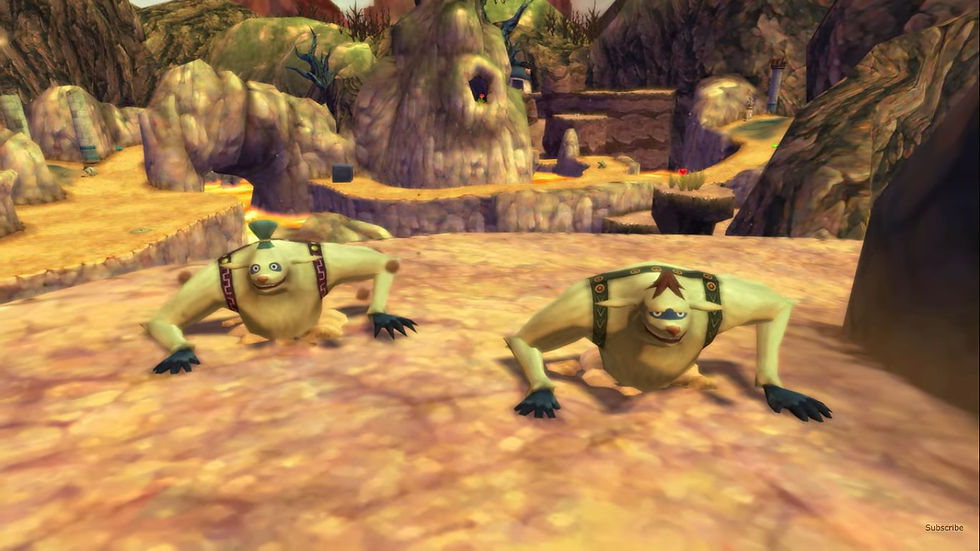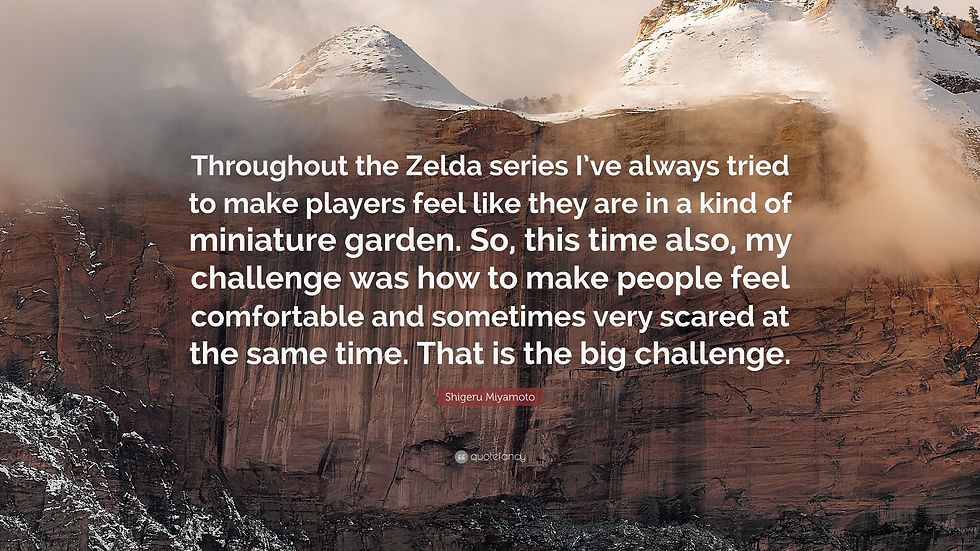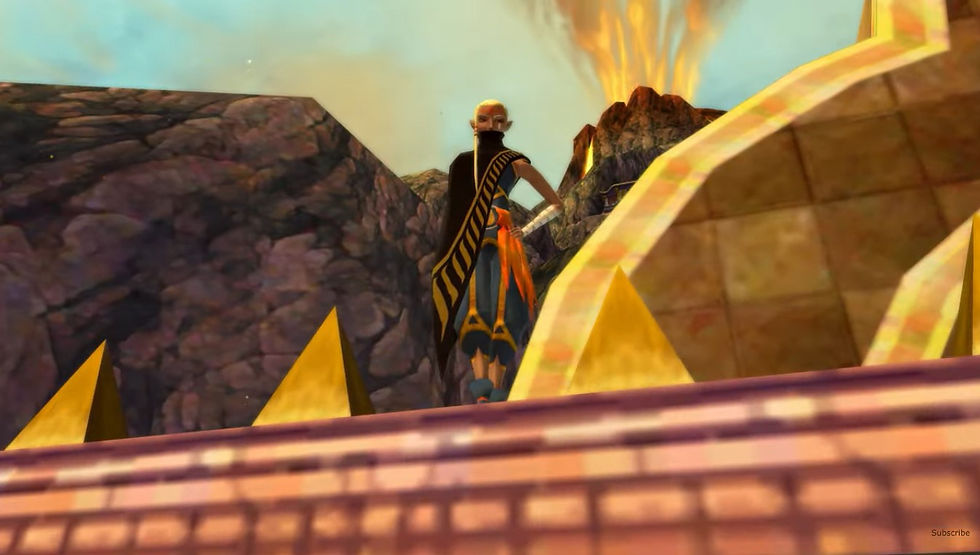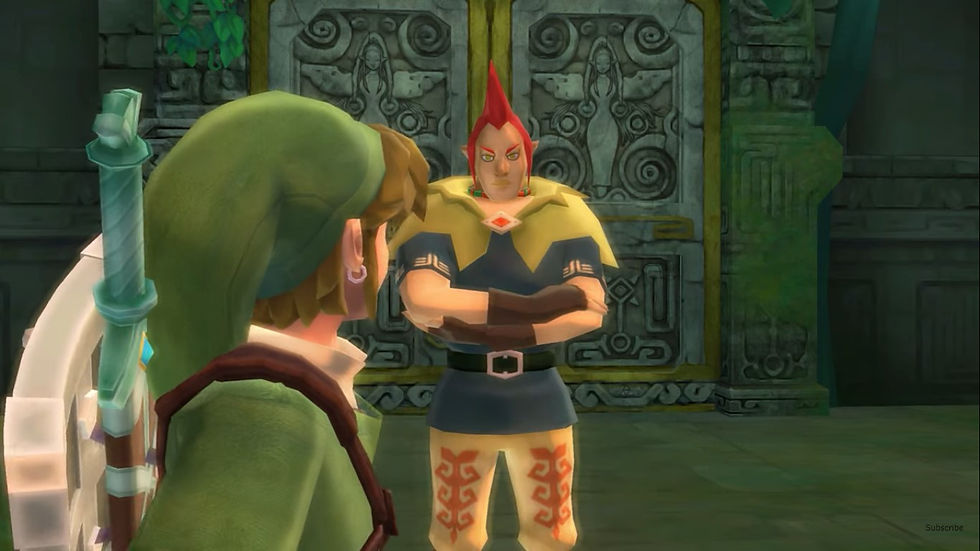Field Note #5: The Garden and the Puzzle Box
- The Wolfess

- Jun 10, 2020
- 6 min read

Base Stats:
Game: Skyward Sword
Version: Original Wii Version, Physical Copy
System: Nintendo Wii U
Session Play Time: 2 hr 18 min
Total Play Time: 8 hrs 39 mins
Content Covered: Eldin Volcano (1st visit) through Earth Temple entrance
Fi Report: 3 Forced Interruptions
Ash from the active volcano drifts through the air and flies in Link’s face. The mountain’s oppressive heat ripples, creating small mirages in the distance. Visibility is low. Towering rocks block his line of sight and particles in the air obscure what remains. Glad that he came properly equipped, the hylian grips his sword and shield a little tighter and sets out into a landscape which is, itself, a challenge to overcome on his way to the dungeon higher up its lava-covered slopes.
Death Mountain. This iconic mountain range has been present in the landscape of Hyrule from the very beginning, way back in 1986 when the Legend of Zelda first premiered in Japan. Back then, Ganon made his home in the heart of Death Mountain at a site called Spectacle Rock. Later, in Ocarina of Time, it would become the iconic home of the Gorons. It remains their home when we see it again in Breath of the Wild. Although it has been called by many names—Death Mountain, Eldin Volcano, or Dragon Roost Island—every game that takes place in Hyrule has seen an iteration of this same volcanic mountain range. Although the rest of Hyrule’s landscape drastically shifts and changes through the ages, this mountain is always present on the northern horizon.
The description in the opening paragraph could match almost any iteration of Death Mountain. Whether we’re talking about its chronologically earliest incarnation, Eldin Volcano in Skyward Sword, or its peak visible above the waves in the Wind Waker, Dragon Roost Island, these elements still ring true: the mountain is in the same northern spot (although Twilight Princess is debatable), it’s an active volcano (often with ash floating through the air in the hottest parts), and it is a challenge to traverse. Traversal often requires specialized equipment, such as a shield that won’t burn (i.e. the Iron Shield or Hylian Shield), something to prevent you from catching on fire (i.e. the Goron Tunic or Fireshield Earrings), and something to help you traverse the landscape (i.e. the digging mitts, the grappling hook, or the iron boots).
To bring this discussion back down to the play session at hand, I’d like to open today’s analysis with an unintentional turn of events: I ended up playing through the same section of gameplay in both Skyward Sword and Breath of the Wild back-to-back. After playing through the section of open-field gameplay leading up to SS’s first fire dungeon, the Earth Temple, the night was still young. Not ready to turn in, I turned on my Switch and booted up an old game file on Breath of the Wild. Ironically, I found myself in Goron City ready to start the same open-field gameplay leading up to Vah Rudania, BotW’s fire dungeon. Although accidental, I found myself in the perfect position to compare-and-contrast the two latest console Zelda games. I couldn’t pass up the opportunity.
I made the same trek through the slopes of the same mountain—tens of thousands of years apart. I played as the first hero and the latest hero. I struggled against the origin of all evil and that entity’s greatest incarnation. I walked through the land of Hyrule before the kingdom was established and after its complete destruction. Despite all this incredible change between the Era of the Sky and the Era of the Wild, one thing remained constant: the mountain itself. Sure, its name had changed from Eldin Volcano to Death Mountain. Sure, its inhabitants changed from the Mogmas to the Gorons. But the mountain itself was the same.

Besides trying to adjust to the drastically different controls—a disorienting experience—the way that Breath of the Wild handles this section of gameplay is very different from its predecessor. Although there are a few enemies and a few (mostly optional) puzzles, the focus of the gameplay in BotW is on exploration and action. There are sections where you are just traveling, mostly unobscured, from point A to point B. You are free to wander off track during these sections as much as you want. There are also a lot of action sequences. You’re firing cannonballs and fighting baddies and sneaking around guardian sentries while attacking the very dungeon you’re trying to enter. All of this feels very organic and integrated with the designed environment. At no point is it obvious what the developers want you to do. You’re just exploring the mountain and coming up with your own solutions to the problems you encounter, even if traveling between major events can sometimes feel long and empty.
Skyward Sword, on the other hand, feels much more compact and curated. Progression through the world is slow and carefully designed by the developers, taking you from one puzzle to the next. Directions they don’t want you to go yet are blocked off, funneling the player toward a particular overworld puzzle. Whether that’s rolling a bomb across a bridge to unplug the lava flow blocking your way into the big tree or fighting off a room full of bokoblins so the mogma will give you the digging mitts that will allow you to ride steam-jets up ledges too high to climb, this game’s puzzles come in rapid succession and build off of one another. Every puzzle you solve unlocks a new portion of the map for you to explore, and another puzzle for you to solve in order to progress.
In an E3 Gaming Expo interview in 1998 right after the release of Ocarina of time, Shigeru Miyamoto, father of the Zelda series, said this:

I don’t think anyone will argue with me when I say that Breath of the Wild fits this description perfectly. It is a giant, lush natural world that you can literally put in your pocket. Like walking in a garden, you can choose where you want to go and what you want to do. Skyward Sword stands out because it doesn’t feel like a garden at all. Instead, it feels more like a puzzle box. Every section of the game is a compact series of puzzles one must solve in order to reach the goal.
This dichotomy speaks to a fundamental difference in the game designer’s philosophy regarding the nature of fun in the Zelda Series. Where some developers might think that exploration and the freedom to choose is at the heart of what “fun” in Zelda is, the developers of Skyward Sword took a different route. They theorized that the most fun part of Zelda was the dungeons, and the dungeons were a series of linear, controlled puzzle solving full of bad guys to kill. So they turned the whole world into a puzzle box like the dungeons. I have read reviews that said that it’s like this because of miscommunication—like perhaps the developers didn’t realize how many puzzles they were putting into the overworld because they weren’t talking to each other—but I don’t think that’s the case at all. I believe it was an experiment in design philosophy.
Unfortunately, this experience was hit or miss with fans. Skyward Sword is a divisive game within the Zelda Community. Some people don’t like it just because of the motion controls. However, I have often heard people say that they don’t mind the motion controls, but they just don’t have fun when playing Skyward Sword. No matter how many times they try to play it, it’s simply not fun for these players. I think this design difference might be a key reason why.

For me, I found this experience very fun. It was a refreshing change of pace from the exploration-focused games I’ve been playing these last three years like Breath of the Wild and Skyrim. My notes from this play session include comments on how much I enjoy the mogma tribe’s jazzy motif, how satisfying it feels to blow up walls to find random treasure, and the simple enjoyment I got out of new game mechanics like rolling bombs. I also thoroughly enjoy using my beetle like a drone to scout out the blocked sections around me.
I do have to take a moment before I conclude this article to shout out the first appearance of my favorite character in this game: young Impa. I’ll talk more about her in a later article, but suffice it to say that my little gay heart was just as excited for her appearance this time as it was almost ten years ago when I first saw her.

In so many ways, Breath of the Wild and Skyward Sword represent two different ends of a spectrum. From a lore perspective, they are on two opposite ends of the timeline and represent two opposite sides of the Kingdom of Hyrule’s history. On a more grounded gameplay level, however, they also represent two opposite opinions on what “fun” is in Zelda. Skyward Sword’s puzzle box design turned off many players due to its lack of freedom and exploration. Some said that it didn’t feel like a true Zelda game. Oddly, the same is often said of Breath of the Wild, whose lack of puzzle and enemy-filled dungeons and overworld challenges left some feeling like it was too empty. I think that the best balance probably lies somewhere in the middle, between these two extremes. Still, I hope that more people will give Skyward Sword’s overworld gameplay another chance. It was a brave thought experiment and can be a fun experience if approached with an open mind.




Comments